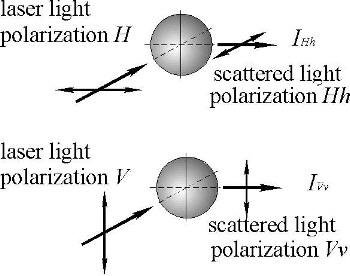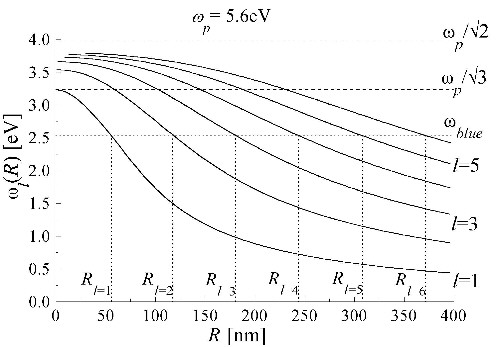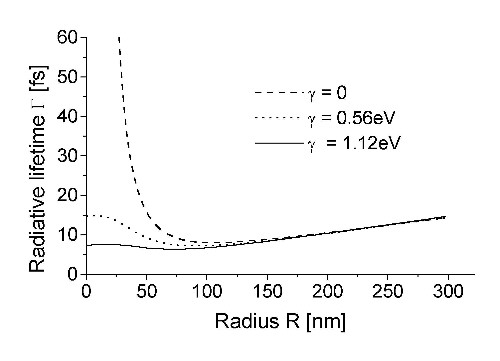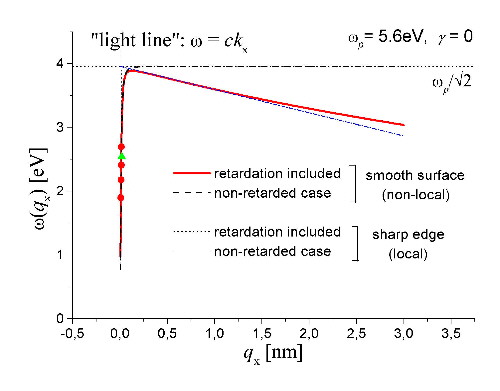|
|
|
Light induced sodium droplets from the vapour phase |
Brief description
The spontaneous growth of light induced sodium clusters from the vapour phase up to macroscopic droplets of radii of about 140 nm is studied. The optical cluster production method takes advantage of the fact, that at temperatures of a few hundred Kelvin the saturated sodium vapour (in thermodynamic equilibrium with the liquid deposit) consists not only of atoms, but also of sodium dimers at no-negligible amount. The production method relies on supersaturating the vapour as a result of light induced dissociation of dimers. The atoms arising from dissociated dimers form an excess of atoms in previously saturated vapour, i.e. they produce supersaturation of the vapour. We observe avalanche initiation of spontaneous nucleation and growth of sodium droplets, when the saturated vapour becomes illuminated with light at wavelength, which is in resonance with a dimer transition. After the light is switched-on, clusters in a heat pipe-type cell (Fig.1) are seen initially as a dense haze evolving into well separated spots, which scatter the light elastically Movie1.

Fig. 1: Heat pipe-type cell scheme.
Our study involves experimental examination of scattering of linearly polarized light (Fig.2) on growing clusters (droplets) at different light wavelengths and its comparison with the predictions of the Mie scattering theory.

Fig. 2: Linearly polarized light scattering geometries.
We checked the validity of describing the ensemble of clusters with a single size at a given time of the growth process. The experimental scattering data were also compared with the model assuming the existence of a dispersion of cluster size, which was allowed to be a nonsymmetric function of sizes Fig.3, (according to [1]), and to change with the progress of the growth process.

Fig. 3: Dispersion of cluster size nonsymmetric function.
On assuming the Drude dielectric function as an external parameter of the Mie theory, the fitting algorithm based on the Mie formulas allowed the value of the dumping rate γ of free electron plasma filling the sodium droplet to be found [1,4].
When the droplets reach the size comparable with the light wavelength, they can be counted one by one. That allowed not only the relative concentration of droplets to be determined, but also the absolute concentration of droplets of a given size to be estimated at successive stages of the growth process.
We assigned the maxima in scattered intensities to secondary fields due to plasmons excited in clusters with appropriate radius (Fig.4, Fig.5) (according to [3]).

Fig. 4: The frequency of plasmon oscillations in sodium clusters curve.

Fig. 5: Damping of plasmon oscillations in sodium clusters curve.
The maxima in measured intensities of scattered light in ''perpendicular'' and ''parallel'' polarization geometry are attributed to excitation of dipole plasmon when cluster radius approaches 55nm and of quadrupole plasmon when cluster size approaches 118nm respectively. The softening of a flat surface due to dynamical screening (described with Feibelman's response function) is incorporated in optics of spherical cluster of arbitrary size (retardation included). The non-retarded limit is also discussed. In particular the shift of the dipole plasmon resonance with cluster size is studied (Fig.6) (according to [3]). These results are compared with some experimental results for sodium clusters.

Fig. 6: Shift of the dipole plasmon resonance with cluster size.
We compare the results of our study with expectations from the classical nucleation theory, formulated in terms of the difference in the Gibbs free energy due to formation of a single droplet, and leading to Kelvin's relation. The light induced supersaturation, which initiates the spontaneous growth of sodium droplets observed by us, is lower by several orders of magnitude than the necessary supersaturation of sodium vapour resulting from Kelvin's relation. We discuss also some of other differences between the experimental situation and assumptions of the nucleation theory. The resulting postulates are the subject of forthcoming modelling.
Publications
-
Demianiuk S, Kolwas K
Dynamics of spontaneous growth of light-induced sodium droplets from the vapour phase.
J. PHYS. B 34: 1651-1671 2001
-
Kolwas K, Kolwas M
Scattering of light by objects of atmospheric particle size
OPT APPL 29: (4) 515-528 1999
-
Kolwas K
Plasmon resonances in a spherical sodium cluster and in a flat surface with a soft optical edge.
APPL PHYS B-LASERS O 66: (4) 467-470 APR 1998
-
Markowicz P, Kolwas K, Kolwas M
Experimental determination of free-electron plasma damping rate in large sodium clusters.
PHYS LETT A 236: (5-6) 543-547 DEC 22 1997
-
Jakubczyk D, Kolwas M, Kolwas K
Study of the formation and growth of light-induced sodium clusters.
J PHYS B-AT MOL OPT 30: (23) 5567-5578 DEC 14 1997
-
Kolwas K, Demianiuk S, Kolwas M
Plasmon resonances observed in light scattered by large alkali clusters.
APPL PHYS B-LASERS O 65: (1) 63-68 JUL 1997
-
Synowiec M, Kolwas K, Kolwas M
Large sodium clusters in an electrostatic field.
Z PHYS D ATOM MOL CL 40: (1-4) 271-275 1997
-
Kolwas K, Demianiuk S, Kolwas M
Dipole and quadrupole plasmon resonances in large sodium clusters observed in scattered light.
J CHEM PHYS 106: (20) 8436-8441 MAY 22 1997
-
Kolwas K
Size dependent index of refraction and absorption of a spherical metal cluster.
Z PHYS D ATOM MOL CL 38: (3) 233-240 OCT 1996
-
Kolwas K, Demianiuk S, Kolwas M
Optical excitation of radius-dependent plasmon resonances in large metal clusters.
J PHYS B-AT MOL OPT 29: (20) 4761-4770 OCT 28 1996
|
|
|

